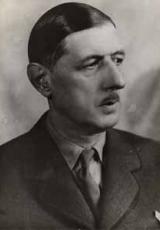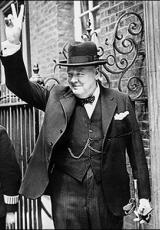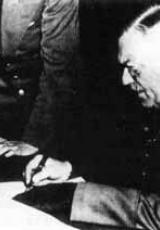14 July 1945
Sous-titre
Parade of victorious troops

From the Arc de Triomphe to Place de la Nation and taking in Place de la Bastille where the official stand was located, the crowd gathered on the parade route through Paris adorned with tricolours. After an interruption lasting six years the French national holiday was again celebrated with Europe finally at peace and the country liberated.
The 14 July 1945 was ”more than ever the National Holiday since France was celebrating both its victory
and its freedom” to quote General de Gaulle.
Three days of commemmoration and public rejoicing celebrated the return of political sovereignty and national unity.
We were nonetheless far from the military splendour of 1919 or the fervour of the Popular Front. France had emerged from war devastated and divided by the fighting and the Occupation. The economic infrastructures needed to be rebuilt and the rule of law and political institutions had to reassert their authority.
The main political forces were in disagreement regarding the country's political future. General de Gaulle, the man behind the Appeal of 18 June and the liberator of France, was in support of strong executive power while the communist party attempted to gain power by calling for the election of a sovereign constituent assembly via the Etats Généraux de la Renaissance Française (a meeting of resistance movements in Paris held from 10 to 14 July 1945).
The differences were also reflected in how the three-day celebration was organised and run starting in the east of Paris on 13 July and ending in the west on the 15th.
The Gaullist memory saw this celebration as part of the myth of Joan of Arc and Napoleon's eternal France following and building on the commemorations of the 6 and 18 June by giving a special place to the centre of Paris alongside the more traditional memorial venues such as the Hôtel de Ville, Concorde and Bastille.
Commemorative events took place at many different times and locations in order to blend the events led by the C.N.R. (National Resistance Council) and the C.P.L. (the Parisian Liberation Committee), organised by the communist party, into a vaster programme of events. The greatness, unity and sovereignty of France were placed centre stage with a succession of official reception parties on the 13 July which saw the arrival of the Bey of Tunis and the reception at the Hôtel de Ville for the allied mayors then the exchange of messages between Chiang Kai-shek and de Gaulle and the reading of the message from Truman.
National sentiment was reignited through the public dances at Concorde and the fireworks at Longchamp as well as the military programme on the 14 and 15 July: review Cours de Vincennes, parade from Bastille to Etoile. The nautical display between Concorde and Pont Alexandre-III, which ended with the appearance on the Seine of a German midget submarine, and the aerial celebration at Longchamp that featured the Normandie-Niémen squadron, fused a day of commemoration with a celebration of the brave.
The wakes along the Champs Elysées and the reverence ceremonies on 13th July at the Opera, Sacré Coeur and Arc de Triomphe in tribute to the war dead - the speech was read out on behalf of General de Gaulle and the government by Frenay, Minister of Prisoners and Deportees - placed the heroes and martyrs as part of the Gaullist national epic.
For its part, the communist memory resurrected the republican tradition and linked the event to Paris' insurrectionary past. The official gallery was thus set up at Place de la Bastille. The C.P.L. (Parisian Liberation Committee) paraded on the afternoon of the 14 between Concorde and Bastille, thus closing the Etats Généraux de la Renaissance Française by taking a route opposite to that taken in the morning, dedicating the republican anniversary to the men of the insurrection and the domestic resistance in the working-class areas of the city. The civilian parade between Concorde and Bastille was reintroduced and echoed the morning's military parade.
Following the example of the 14th of July 1936, the event shone a light on regionalism and the history of the Revolution as depicted by decorated floats. The former international brigade volunteers paraded at the Communards' Wall. The outdoor shows and local dances in the various areas of Paris and outside the capital contrasted with the solemnity of the official events. As the German midget submarine headed up the Seine, the centrepiece of the nautical event, the theatres of Châtelet and La Gaîté meanwhile put on matinée performances free of charge where spectators could see, for instance, French dramatist Romain Rolland's play Danton.
The communist memory, by celebrating the resistants and the people, centred its commemorative programme on the events of the past and those of the future. It finished by winning out over the solemn and remote Gaullist memory: it was a deportee who on the evening of the 13 July spoke about national unity in the name of the government and General de Gaulle.
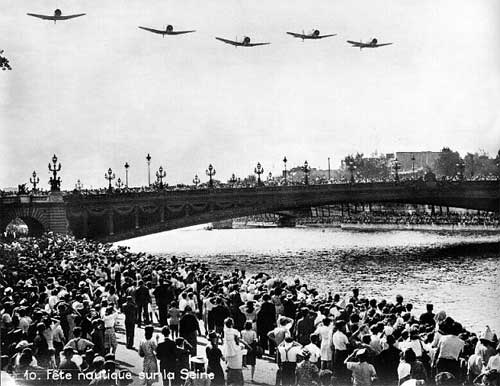
Célébration du 14 juillet après-midi. Fête nautique sur la Seine.Photo MINDEF/SGA/DMPA
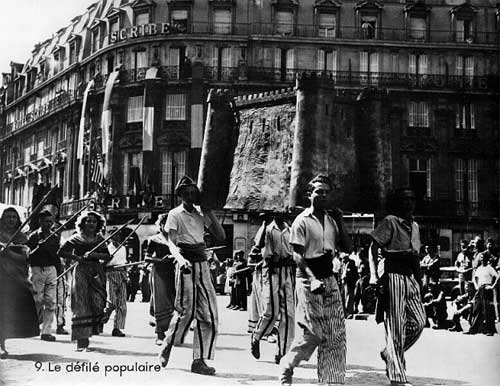
Célébration du 14 après-midi. Paris. Le défilé populaire de l'après-midi. Photo MINDEF/SGA/DMPA
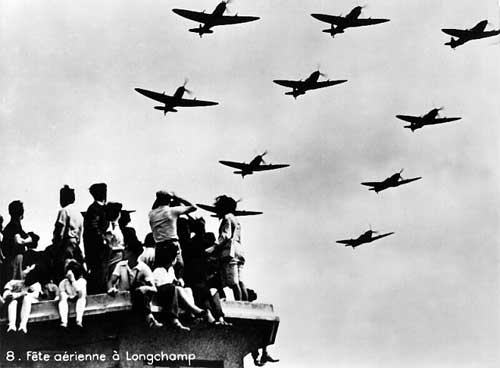
Célébration du 14 juillet, à 15h00. Fête aérienne à Longchamp. Photo MINDEF/SGA/DMPA


